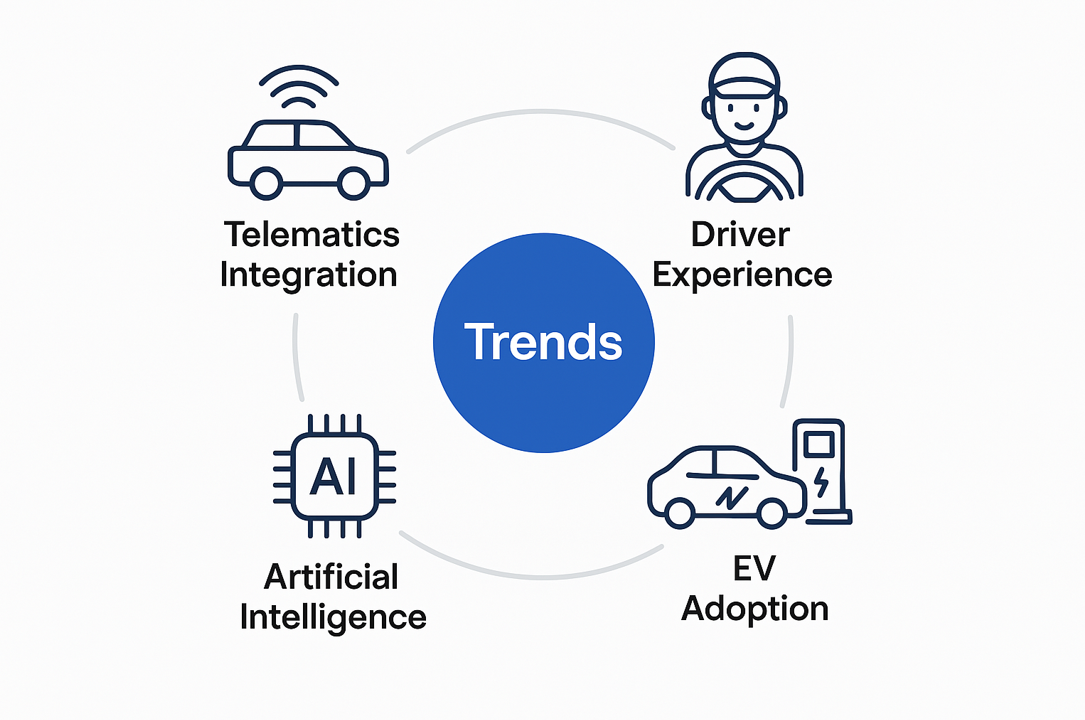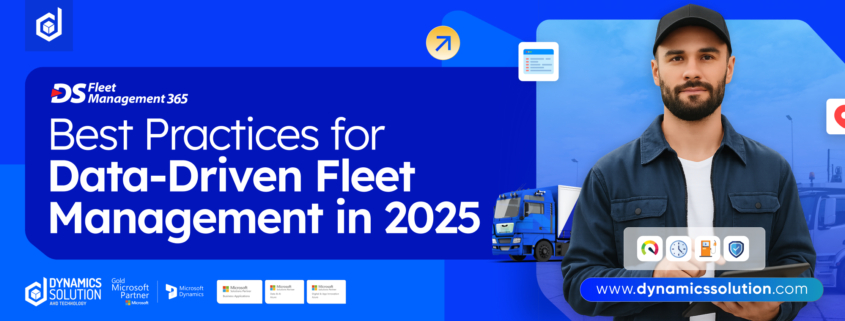Fleet management has reached a turning point. Gone are the days when businesses could rely on spreadsheets, siloed systems, or the occasional telematics update to run vehicle operations. In 2025, fleet leaders face a far more complex environment, one that demands data maturity, strategic agility and technology integration.
The role of the fleet management system has expanded from a back-office tool to a central hub for day-to-day operations. Whether it’s monitoring electric vehicle performance, ensuring driver compliance or using AI to forecast maintenance, today’s fleets are shaped by the quality of their data and how effectively they act on it.
At the same time, fleet operators are navigating growing pressure to meet evolving standards. Whether it’s regulatory compliance, sustainability goals or rising customer expectations. While emerging technologies like AI, IoT and electrification offer powerful solutions, integrating them into everyday operations isn’t always straightforward. The challenge isn’t just having access to data and tools; it’s knowing how to connect, scale and apply them effectively in a fast-moving environment.
How to tackle it? By keeping your eyes wide open. The best starting point is to understand the key trends and what’s driving them.
Trends Set to Transform the Landscape

1. Telematics Integration is Getting Smarter
Fleet connectivity now comes from both Original Equipment Manufacturer (OEM)-installed systems and aftermarket telematics devices. While these once operated in silos, modern fleet management systems are bridging the gap, consolidating data from both sources into a unified dashboard. This integration gives managers a complete view of vehicle performance and allows greater flexibility when choosing telematics solutions.
2. The Driver Experience Takes Center Stage
With a global driver shortage, fleets are shifting focus from strict monitoring to ensuring safety and job satisfaction. Technologies like AI, Advanced Driver-Assistance Systems (ADAS) and video telematics now support, not surveil—drivers. These tools enhance safety, reduce fatigue and create a healthier driving environment, making it easier to recruit and retain skilled drivers.
3. Electric Vehicle (EV) Adoption Requires Smarter Planning
The rise of electric fleets isn’t just about going green, it’s about being strategic. Fleet management systems now analyze routes, mileage and charging infrastructure to recommend which vehicles to electrify. These tools also track battery health, optimize charging and ensure compliance with local sustainability goals, making the transition to EVs smoother and more cost-effective.
4. AI Is Powering the Everyday Fleet
Artificial intelligence has become a behind-the-scenes workhorse for fleets. From real-time route optimization to predictive maintenance and energy management for EVs, AI simplifies daily operations. It considers variables like traffic, weather and driver conditions to make smarter decisions, while saving time and improving service reliability.
From Trends to Action: Turning Insights into Results
Understanding these key trends is just the beginning. To truly harness the power of data and technology, fleet managers need actionable strategies that drive smarter, safer and more efficient operations. Let’s dive into the best practices shaping fleet management success in 2025.
1. Build a Data-Rich Fleet Management System
Today’s fleets are complex ecosystems; covering fuel, maintenance, inspections, driver behavior, route optimization, compliance and often multiple locations. Managing this with disconnected tools causes inefficiencies and costly errors. That’s why nearly 60% of fleets now use centralized software platforms to unify asset, fuel and maintenance data.
Consolidating everything into one real-time dashboard helps managers spot trends faster, improve collaboration, and cut admin work by up to 35%. The key is choosing a platform that integrates telematics, GPS, fuel cards, and ERP systems to break down silos and boost ROI.
2. Turn Vehicle Data into Predictive Maintenance Schedules
The traditional “fix it when it breaks” approach is obsolete. Predictive maintenance is the new standard.
According to a recent study, fleets that adopt predictive maintenance reduce unplanned downtime by nearly 32%, while extending vehicle lifespan and lowering repair costs. By continuously analyzing diagnostic trouble codes (DTCs), mileage, temperature and performance data, your system can automatically flag incoming service needs, before they become costly breakdowns.
So, integrating predictive maintenance directly into your fleet management system so schedules, alerts, and work orders are automated and connected to vendor workflows.
3. Use Real-Time Telematics for Driver Behavior and Safety
Driver behavior affects more than just safety. It impacts fuel usage, insurance costs and brand reputation. In 2025, leading companies are using real-time telematics and AI to monitor patterns like harsh braking, rapid acceleration, cornering, idling and even distracted driving.
Fleetio’s survey found that 62% of fleet managers now use telematics to monitor driver behavior and the trend is growing as insurance carriers offer better rates for fleets that demonstrate safe operations.
By integrating driver scorecards into your fleet management system, you can coach underperformers, recognize top drivers and create a data-informed safety culture. Hence, don’t just collect safety data, act on it. Schedule monthly feedback sessions, provide training and align incentives with measurable KPIs.
4. Automate Regulatory Compliance
Regulations, from electronic logging device (ELD) mandates to emissions limits, are changing rapidly. Non-compliance risks costly fines and reputational damage. Modern fleet systems automate compliance tracking for Hours of Service (HOS), Driver Vehicle Inspection Reports (DVIRs), license renewals and inspections, sending alerts before violations occur.
With 49% of fleet pros citing compliance as a top challenge in 2025, automation is essential. Choose systems with built-in regulatory templates, ELD integration, and location-specific compliance features.
5. Analyze Performance With AI-Powered Dashboards
The difference between average and high-performing fleets isn’t how much data they have, it’s what they do with it. AI and machine learning are now helping managers discover insights they didn’t know what to look for.
AI-enabled systems can:
- Recommend optimized routes based on weather, traffic, and fuel usage
- Predict which vehicle types perform best for specific regions
- Flag underused assets for resale or redeployment
With customizable dashboards, CFOs can see cost per mile in real time, while operations teams monitor downtime trends, all from one system.
6. Make Fuel Efficiency a Strategic Metric
Fuel remains one of the top operating costs for fleets. With fluctuating prices, electric vehicle integrations, and sustainability goals, efficiency is no longer optional—it’s strategic.
Fleetio reports that 53% of fleets track fuel data manually leaving enormous room for improvement. The best systems automate fuel tracking through fuel card integrations, telematics, and real-time consumption metrics.
Pair that with driver behavior monitoring, route optimization, and EV battery analytics, and you’ll start seeing measurable reductions in fuel-related costs.
Best Practice: Set up a fuel dashboard in your fleet management system that highlights anomalies, weekly consumption, and vehicle-level efficiency.
7. Ensure Scalability with Modular Architecture
Whether you’re operating 30 vehicles or scaling to 300, your fleet tech should grow with you, not hold you back. Traditional solutions often force businesses into rigid workflows and expensive customizations.
Cloud-based, modular fleet management systems allow you to start with what you need—asset tracking, maintenance, inspections—and add features like route optimization or finance integration as you grow.
Choose platforms built on scalable foundations like Microsoft Dynamics 365, which offer seamless expansion and integration with your existing business tools.

2025 is the Year to Get Ahead
Fleet operations have become a battleground for operational efficiency, cost control and customer satisfaction. And in this high-stakes environment, the companies that win are the ones who embrace data-first fleet management systems, not as a tool, but as a strategic differentiator.
With AI, real-time monitoring and intelligent workflows, it’s no longer about just managing vehicles. It’s about transforming your fleet into a competitive advantage.
Ready to Modernize Your Fleet?
At Dynamics Solution and Technology, we help companies do more than manage vehicles; we help them transform how they move.
As a Microsoft Gold Partner, we develop powerful, fully customizable fleet management systems built on Dynamics 365. Whether you’re a logistics giant or a growing delivery fleet, our platform adapts to your goals, with predictive insights, compliance automation and end-to-end visibility.
- Built on Microsoft Dynamics 365
- Custom dashboards, workflows, and analytics
- Integration with telematics, finance and HR
- Scalable architecture for growing fleets
- Trusted by industry leaders across sectors
Let’s drive smarter together. Contact Dynamics Solution and Technology for a personalized demo and see how our fleet solutions can deliver results from day one.






